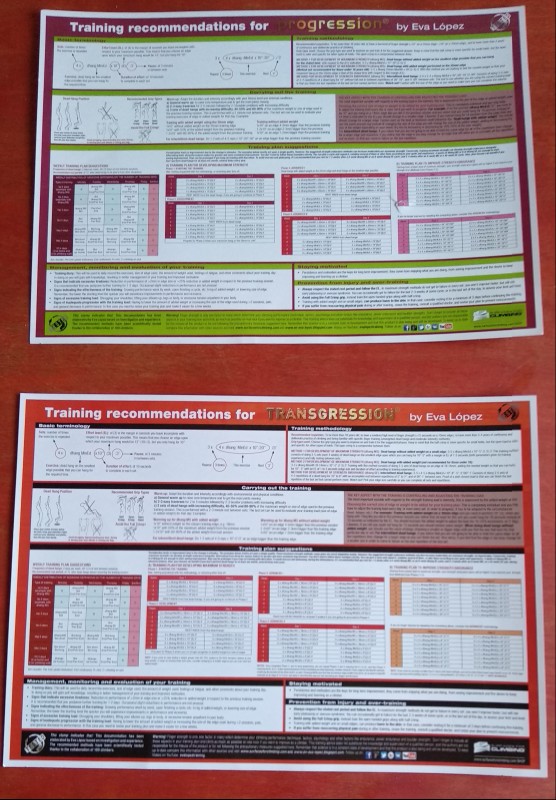Versión en español
Noè and Quaine (2001), observed that in a ten-degree overhanging wall, the percentage of body weight supported by the hands and arms was 62%, compared to 43% for a vertical wall.
 |
| Wolfgang Güllich and Kurt Albert |
A key performance factor is one that allows us to set us apart from other sports, or can be used for talent detection, classifying climbers, or even as a predictor of performance. This means that by improving said factor, we would be improving also our level in the sport.
Grant et col., in their 1996 study, showed that initiated climbers (redpointing at least 6a) did a significantly higher number of pull-ups than beginners or non-climbers. Analog results were obtained by Lezeta (2000), Lehner and Hayters (1998) and Leong (2009) among climbers of varying levels.
The same tendency has been found in the maximum 90º lock-off time (Grant et al 1996; Balas et col, 2011).
 |
| Pablo Beltrán in an 8a+ at Margalef's Laboratori . Photo: Javipec |
This said, I suspect that this is exactly the other way around for female climbers...
Female climbers and Upper Body Strength
Balas et al. (2011) found correlation between a 90º lock-off test and sport level, of 0,76 for men and 0,80 for women. Performance in this test was significantly higher for men than women, and this difference was even higher in the lower levels. These gender differences have been observed by other authors as well (Mermier et col, 2000; Binney and Cochrane, 2003; Leong, 2009).
 |
| Mina Leslie-Wujastyk |
 |
| Reme Arenas. Proximo Bambino, 7b (Cuenca, Spain). Photo: Luis Alfonso Felix - Source: facebook |
- about 60% when adjusting for body weight,
- 70-75% when considering lean body mass (Stone, Stone and Sands, 2007).
So, it seems plausible that women who improve this aspect, would reap some performance gains. This, in fact, is what most of the authors propose, and what my personal experience confirms.
 |
| Girls, let's do some weights and pull-ups! |
Then, is locking-off a key performance factor?
Now, saying that there is -referring to both genders now- correlation between some test and performance does not mean that the exercise is unavoidably connected to performance, but rather that it measures some abilities that it has in common with performance factors. In this case, it tells us that upper body strength is important for climbing.
So the next question to ask is this:
- Can this relation be explained because there is a connection between a maximum isometric test like lock-offs and a dynamic one like pull-ups as we explained in the previous entry,
- or because lock-off ability is a performance factor?
The answer won't be found in the researchers' articles. I have not found any studies that look at the relation between lock-off and pull-ups tests in climbers, male or female, or at the evolution of these qualities after a pulling force or lock-off training cycle respectively.
 |
| Anna Stöhr. Bouldering World Cup, Vail, CO (USA) 2012. Photo by Heiko Wilhem |
In this same line, Binney and Cochrane (1999), propose as an specific test of elite climbers' performance, the ability to pull until exhaustion on a campus board with 30 mm edges 200 mm apart, given the high correlation found, of 0,92 and 0,82 for males and females respectively. Another specific test for upper body power, related to performance in climbing, is Draper et al. (2011) "Powerslap", which consists of hanging off two good holds and doing an explosive pull to reach with one hand as high as possible (r2=0,51); there's a similar "campus test" by Leong (2009), with which a correlation of 0,88 and 0,77 for men and women was observed.
Based on these results and my own experience, my current position on this topic is that locking-off, in modern climbing and with the exceptions that we will comment in another blog post, is not a general key performance factor.
And the limiting factor for most routes and overhang angles is...
...being able to reach the next hold, not the ability to maintain certain angle for a long time. There are two aspects that condition a successful reach:
- the initial impulse force together with the coordinated action of the whole body (especially legs, shoulder and triceps in long reaches); this can be trained through pull-ups, campus board over big holds or boulder problems with long moves.
 |
| Dorothea Karalus. Headcrash, 8c. Frankenjura - Source: dorokara.wordpress.com - Photo: Dorothea's collection |
 |
| Iris Matamoros. Baltzolita, 8c. Baltzola (Bilbao). Photo: Gemma |
 |
| Magnus Midtbø, a climber with an exceptional level of maximum strength. Source: this video |
Apart from making them slow, inefficient and indecisive while climbing, induces unnecessary stress on the elbow, a relatively small area where a lot of structures converge (bicipital aponeurosis, ulnar colateral ligament, ulnar nerve, pronator teres, flexor muscles); when all of them in unison experiment shortening/stretching, high tension or compression (specially with a pronated grip), and the reduced blood flow associated to isometric contractions, we can easily visualize the risk of overuse and injury.
The issues discussed in this entry almost entirely kept me and my trainees from training lock-offs. But now that I have done a more thorough review of the current knowledge in this matter, I realize (repeat with me) that things are not so simple, and at least it's necessary to revise the current concept of lock-off, and its training methodology.
RELATED LINKS:
Lock-off Strength Training (I). Does Static (lock-offs) Training have any Effect over Dynamic (pull-ups) Performance?
Lock-off training (III) Do you really lock-off?
REFERENCES
- Arija, A. (2007): Relación entre una dominada a máxima velocidad y repeticiones máximas hasta el fallo en escaladores y no escaladores. Trabajo para obtención del D.E.A. Facultad de CC de la Actividad física y el deporte. Universidad de Castilla-La Mancha. Dr.: Navarro Valdivieso, F.
- Baláš, J., Pecha, O., Martin, A.J., Cochrane, D. (2011): Hand–arm strength and endurance as predictors of climbing performance. European Journal of Sport Science, 2012. 12(1): p. 16-25
- Binney, D.M. and Cocchrane, T. (1999): Differences in strength between males and female competitive rock climbers.
- Binney, D. M. and Cochrane, T. (1999). Identification of selected attributes which significantly predict competition climbing performance in elite British male and female rock climbers. Journal of Sports Sciences, 17(1), 11-12.
- Brent, S., Draper, N., Hodgson, C., Blackwell, G. (2009): Development of a performance assessment tool for rock climbers. Eur J Sport Sci 9(3): 159-167
- Draper N, Dickson T, Blackwell G, Priestley S, Fryer S, Marshall H, Shearman J, Hamlin M, Winter D, Ellis G. (2011): Sport-specific power assessment for rock climbing. J Sports Med Phys Fitness. Sep;51(3):417-25.
- Giles L.V., Rhodes E.C., Taunton, J.E. (2006): The physiology of rock climbing. Sports Med; 36(6):529-45.
- Grant, S., Hynes, V., Whitaker, A. and Aitchison, T. (1996): Anthropometric, strength, endurance and flexibility characteristics of elite and recreational climbers. Journal of Sports Sciences, 14, 301-309.
- Grant, S., Hasler, T., Davies, C., Aitchison, T. C., Wilson, J. and Whitaker, A. (2001): A comparison of the anthropometric, strength, endurance and flexibility characteristics of female elite and recreational climbers and non-climbers. Journal of Sports Sciences, 19, 499-505.
- Lehner, C and Heyters, C. (1998): Tests d' aptitudes physiques spécifiques et mesures de laboratoire adaptes à l'escalade: Application aux grimpeurs de haut niveau. Sport Belgique. 163: 43-53
- Leceta Aulestia, F. J., (2000): Evaluación de la fuerza en la escalada deportiva.
- Revista Digital. Buenos Aires. Año 5. Nº 21. Mayo 2000.
- http://www.efdeportes.com [Consulta: 10/07/2012]
- Leong, C.H. (2009): A comparison of upper body power, strength, endurance and flexibility characteristics of sport climbers and boulderers. Thesis presented to the Department of Kinesiology. California State University. In partial fulfillment of the requirements for the Degree Master of Science in Kinesiology Option in Exercise Science.
- Mermier, C.M. Janot, J.M.; Parker, D.L.; Swan, J.G. (2000): Physiological and anthropometric determinants of sport climbing performance. Br J Sports Med;34:359–366
- Noé, F.; Quaine, F.; Martin, L. (2001): Influence of steep gradient supporting walls in rock climbing: biomechanical analysis. Gait and Posture 13; 86 – 94
- Stone, M.H., Stone, M. and Sands, W.A. (2007): Principle and Practice of Resistance Training. Human Kinetics
- Wall C.B., Starek J.E., Fleck S.J., Byrnes W.C.(2004): Prediction of indoor climbing performance in women rock climbers. J Strength Cond Res. Feb;18(1):77-83.
- Watts PB, Martin DT, Durtschi S (1993): Anthropometric profiles of elite male and female competitive sport rock climbers. J Sports Sci 11:113–117






 https://orcid.org/0000-0003-0304-5290
https://orcid.org/0000-0003-0304-5290







